
Brampton’s dream of its own university has more questions than answers
Brampton’s want for its own university outweighs the details the city has made public in showing how this project will come about. BramptonU is the city’s initiative to get Canada’s largest city without a central university its own accredited institution, following in the steps of many other Ontario municipalities that share names with their primary post-secondary institution, including the University of Toronto and University of Waterloo.
Jason Tamming, Brampton’s Director of Strategic Communications, told The Pointer via email that on January 28, the city will host a town hall to “receive public input, share additional details about the proposal, and outline the results of public polling.” A majority of the remaining details depend on the outcome of the proposal the city will submit to the province as part of the process to gain authorization to become a university. Tamming said this will be handed to the province for review in the first quarter of 2020. “The city’s business case will outline the market demand and educational case for a university in Brampton. We look forward to further deliberations with the province on meeting those education demands that support the Brampton and Ontario economy,” Tamming said. However, there is a possibility that an earlier submission could land on the province’s desk. “The City is preparing a pre-budget submission for the province, that includes relevant information and requests related to BramptonU,” Tamming added.

The initiative was launched through a video announcement that saw Mayor Patrick Brown announce the idea standing next to Regional Councillor for Wards 1 and 5 Rowena Santos and City Councillor for Wards 9 and 10 Harkirat Singh in November.
It was accompanied by a website (click here) that outlines how the city plans to root together the initiative. Since the marketing launch, a number of public engagement events have taken place, Tamming said. This includes a tele town hall with the mayor and councillors alongside Brampton PC MPPs Amarjot Sandhu and Prabmeet Sarkaria, who is also the Associate Minister of Small Business and Red Tape Reduction. Tamming said more than 14,000 residents connected that day, with 83% feeling that it was important for Brampton to house its own university. Other events include research from telephone surveys and a Ward 7 and 8 town hall hosted by the Councillor for the area, Charmaine Williams, where residents were able to learn about the university concept and ask questions. Tamming said the city is also building partnerships with institutions both at home and around the world to have post-secondary partners quickly lined up to progress with the project once a decision is made by the province.
Doug Ford’s government previously pulled funding for a Ryerson University satellite campus that was in partnership with Sheridan College in the city’s downtown, in a space right next to the GO station. The City of Brampton lost $90 million in funding that the previous Liberal government had set aside, a decision that also impacted Milton and Markham, which also lost the funding for new universities that the previous Liberal government had committed to.
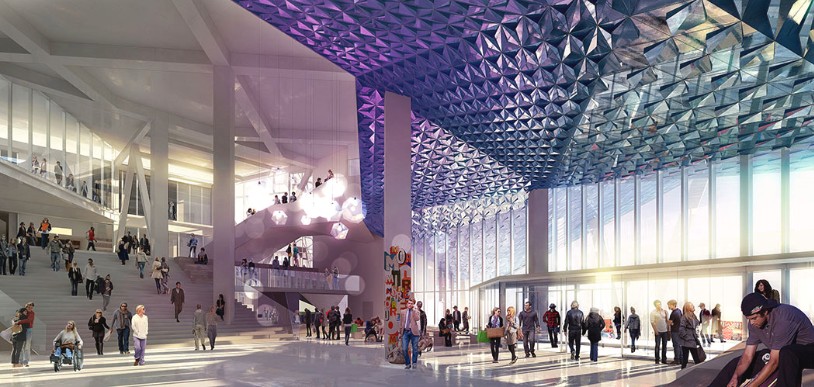
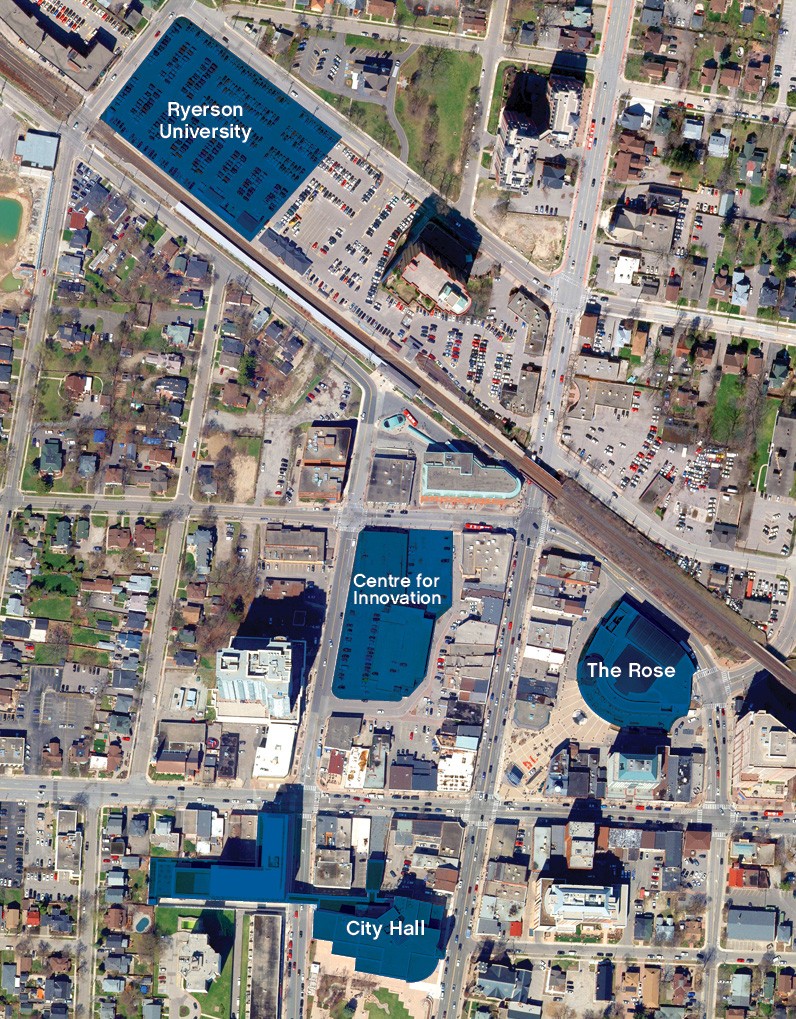
Above, a rendering of the cancelled Ryerson University campus and a map showing where it was going to be located
“As part of the Ontario government’s expenditure management process and given the fiscal constraints facing the province, the government is not in a position to provide capital funding for the Markham, Milton and Brampton campuses,” Ciara Byrne from the communications department of the Ministry of Colleges and Universities told The Pointer. While the city has received an interest from the province in the past, it’s not immediately clear if it will approve the upcoming university proposal the city is readying to submit.
What also remains unclear is the involvement of either Ryerson or Algoma in the plan for a full Brampton University campus. It’s unlikely that either university, following their substantial investment commitments to help build post-secondary education here, would be happy about being cut out of any plan for a full campus.
After the Ford government suddenly cancelled the $90 million of funding for the downtown campus in October of 2018, Ryerson informed The Pointer that it had no choice but to withdraw from the centrepiece downtown campus project that had been set to be built on the selected site next to the GO station.
Downtown councillors Santos and Paul Vicente, clearly upset over the negative news for their wards and trying to do damage control, voiced their displeasure to The Pointer for publishing that Ryerson had pulled out of the project, claiming it was a misrepresentation and emphasising that the university was fully committed to other project partnerships with the city.
Ryerson already runs its Chang School of Continuing Education out of its downtown location and is currently working with city hall to create an “Innovation Zone” (read about it here) which is part of the University’s larger network to support the creation of businesses and ideas that can become full functioning economic ventures in the city.
According to a statement on the city’s website, this innovation center will open in early 2020. The Innovation Zone will be part of Brampton’s larger Innovation District planned to house other entrepreneurial and tech-based initiatives. These initiatives will be located in the Center for Innovation within the district. In order to create the space for this, the city is demolishing city-owned buildings downtown between January 16 and 23 to make room for the development. While the city also has partnerships with Algoma University and Sheridan College, a full university campus project still does not exist, since Ryerson had to pull out of the campus plan because of the Ford government’s decision to withdraw the $90 million funding commitment. The city’s two existing university partners offer a variety of programs in the health, business and science fields, with Algoma recently announcing a major plan to expand its downtown presence into a much larger campus, for which council committed $7.3 million in August.
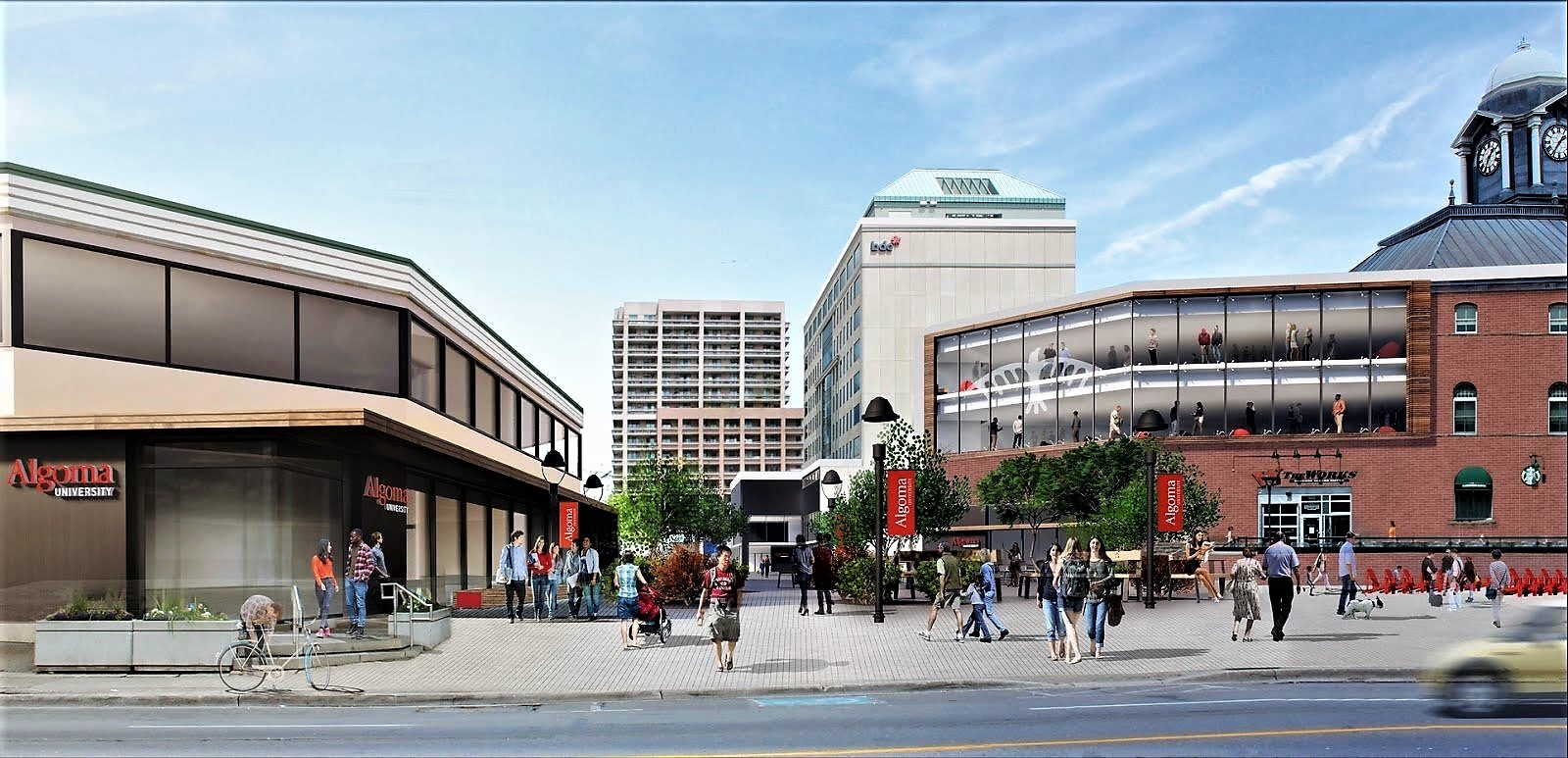
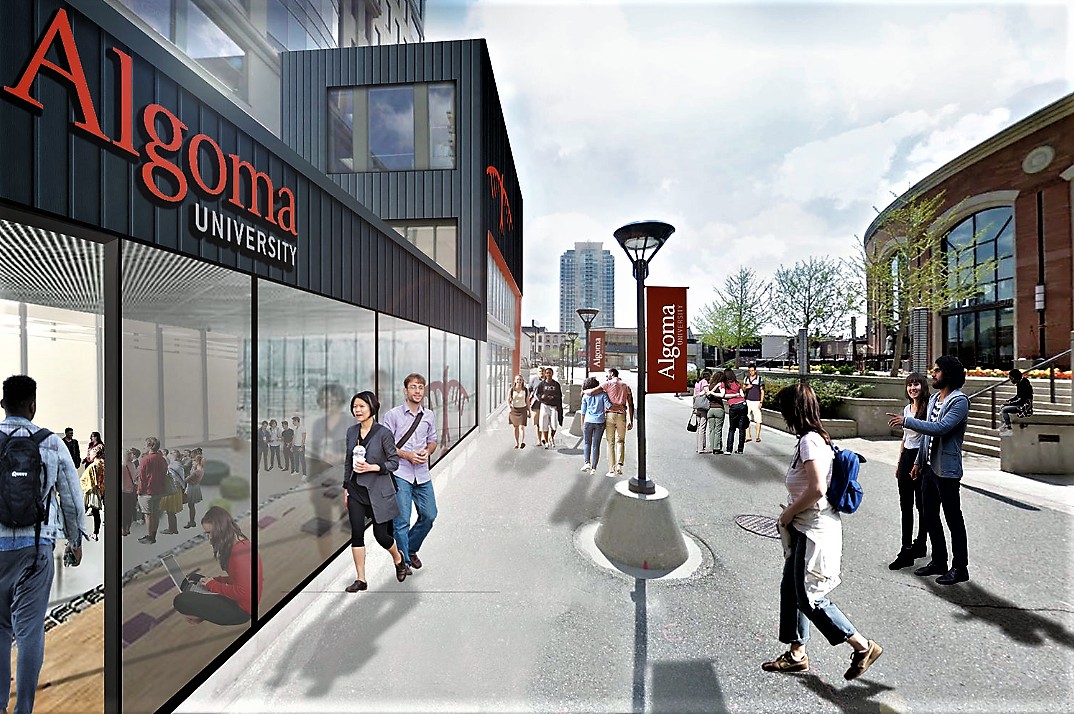
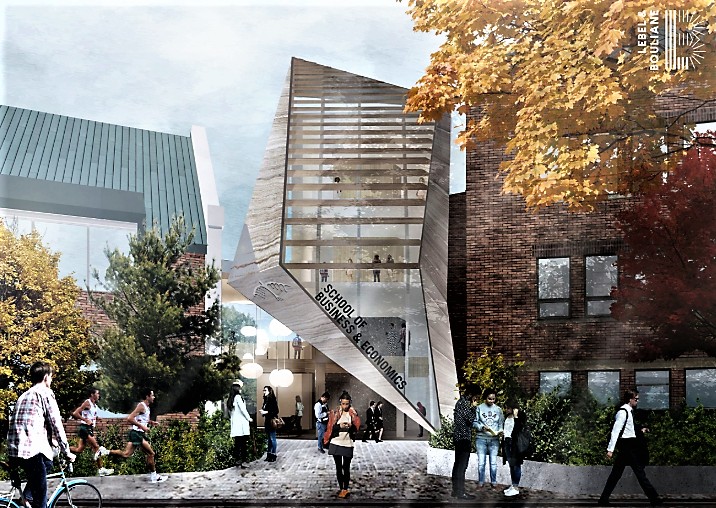
Renderings show plans for Algoma University's $34.4 million expansion project in downtown Brampton
But it’s clear that with almost 650,000 residents, projected to reach about 900,000 by 2040, that Brampton families need a comprehensive degree-granting campus with a university that offers a range of educational options for students. Currently, Brampton is the largest city in Canada without its own stand-alone university campus, while much smaller centres, such as Kitchener-Waterloo, have more than one full university campus.
This puts increased financial burden on many Brampton households that have to cover much higher costs to send family members to university outside the city. It also raises questions about why Brampton taxpayers help fund universities across Ontario through their provincial income tax, while the city continues to be deprived of its own institution, despite the sizeable financial contribution from local income earners who send money to Queen’s Park that seems to be going to other communities.
In 2014, when former mayor Linda Jeffrey quit the Liberal government and left her cabinet post to seek Brampton's top job, bringing a university to the city was one of her top campaign promises. But her failure to secure a campus marked years of earlier setbacks that have left local families wondering if they will ever see a full university campus in one of the country's fastest growing cities, where there is significant demand for local post-secondary education.
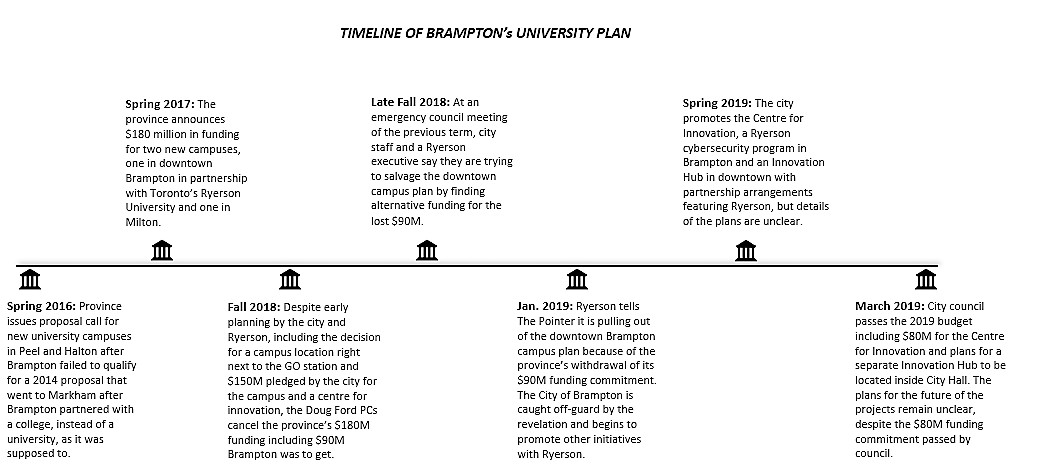
The end goal is for BramptonU to become an accredited university of its own, but the process to achieve this can take years. Take Algoma University for example; it took the institution years before it was accepted as an official university. According to the university’s website, it originally started off as an affiliate with Laurentian University in 1965. In 1994, it had its first attempt at independence rejected after sending a charter to the Ministry of Education and Training. In 2007, it tried again and was granted independent status by the Liberal government of the day, and in 2008, Algoma became Canada’s youngest university. “We developed as a university college affiliated with Laurentian University and then in 2008, after 40 odd years of development in the post-secondary sector [and] through an act of legislation known as the Algoma University Act (or Bill 80), we became independent,” Brian Leahy, Director of Communications for Algoma University previously told The Pointer.
It’s also not clear how Brampton residents might be impacted by the creation of the university. For one, a location for the university hasn’t been decided and it’s not clear what neighbourhoods could be impacted by construction, possible road closures and other inconveniences. Funding is another grey issue. According to the BramptonU website, the plans for the university, referred to as the Blueprint, will come together from $300,000 the city has set aside for the project that came from previous budgets. According to the 2019 budget, $25,000 sat in the Brampton University Reserve Fund at the end of 2018. The Pointer was unable to confirm how much money was set aside for the project since. Previous budget documents also state funding for the Brampton University plan would fall under discretionary reserve funds, money that is gathered over the years to be used on a future project.
While the BramptonU website states this project won’t lead to a tax increase for now, as the city hopes to get funding from multiple stakeholders and create a “self-funding” university that won’t lead to an increase in taxes, it doesn’t mean the funding plan will stay that way. Insufficient funding is something the city has been struggling with and the 2019 tax freeze didn’t help the case, as less money came in from residents across the city. In the long run, maintenance of important aspects of the city suffer and the city has already put a number of projects on hold.
A recent example of budget planning that doesn’t align with the growing list of projects the city needs, was news last week that Brampton will have to come up with 25 percent of the cost of expanding Peel Memorial hospital, if it wants the province to move forward with the Phase II plan. Staff and council members will now be scrambling to figure out how to raise as much as $150 million (possibly more) to get the city’s share for the desperately needed hospital expansion. Other than $20 million raised years ago from a special levy paid by property owners, the city has no designated funding for the hospital plan and is now caught flat footed.
Brampton is Canada’s ninth largest city and the potential benefits of the university plan are vast. It will give people more options at a chance to receive an education from a public institution in the city. This, in turn, could keep more high-skilled employees in the city to apply their academic knowledge, instead of leaving to other cities to pursue an education, and having the option of not coming back to Brampton once in the workforce.
A university could also help the city move away from its low-skilled manufacturing base and the low-return warehousing and transportation businesses that have not done much to lift the city’s struggling economy. The future is all about knowledge, advanced manufacturing, research and development and the hundreds of emerging computational-based innovation fields. The largest and best paying employers in the world are already in the various technology sectors, and this trend will only expand.
“BramptonU will ensure that we can develop and retain homegrown talent. Our goal is for BramptonU graduates to be uniquely qualified to build their lives and careers based on the knowledge and experience they gain here,” the BramptonU website states.
The city has also hired two consultant groups, the Academy for Sustainable Innovation and Stakeholder Research Associates to look into the options for BramptonU. The website states that the Academy for Sustainable Innovation will specifically look at “academic planning and partnership development”, while the latter consultant group will look at how stakeholders engage with the project. Stakeholders include residents, businesses, community groups and the government.
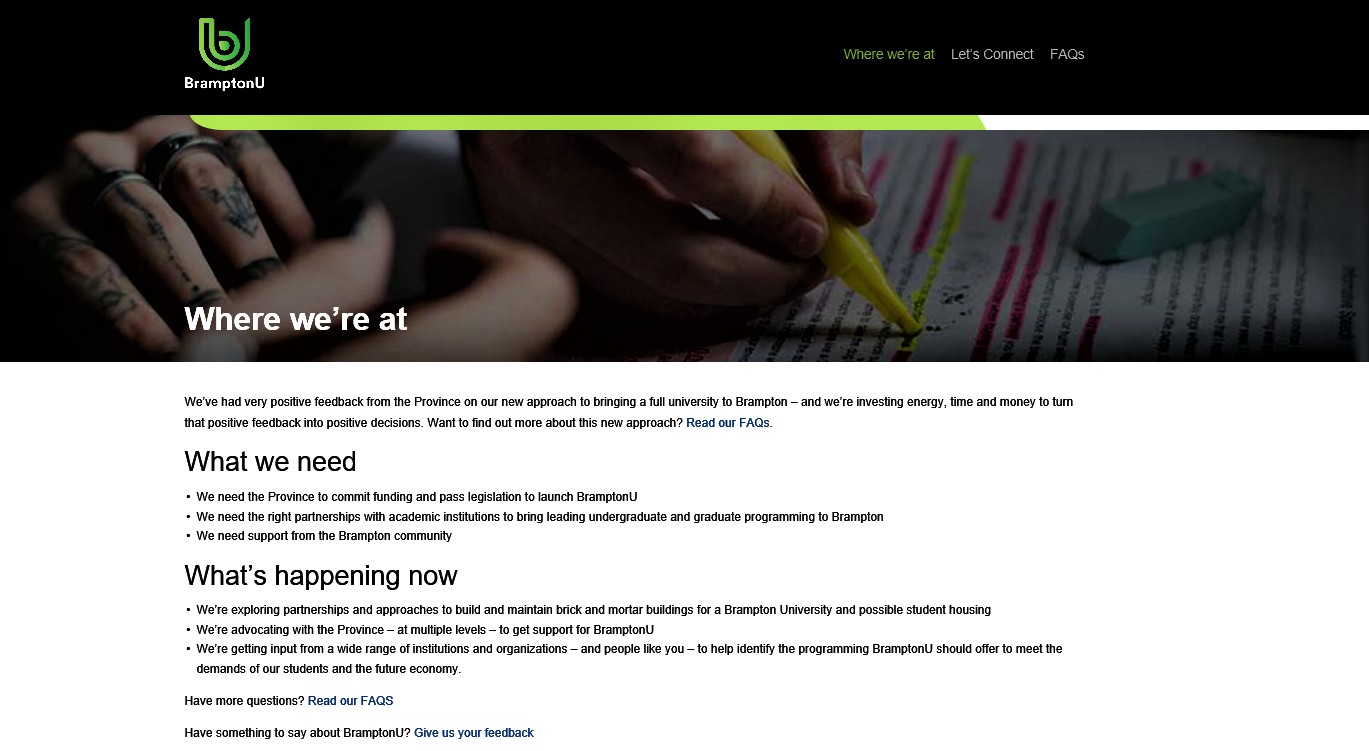
While the concept itself is unique, the numerous and complex steps needed to take the idea from just a marketing campaign to the implementation of a complete strategy for the creation of a full university institution in Brampton are what lead to more questions than answers.
City staff could not provide many details and it seems clear that the plan right now is little more than an idea.
Asked if BramptonU might not pull through like a number of projects faced by the city, Barrick told The Pointer the initiative has received an interest from the province. “Both local provincial representatives, and representatives from the Ministry of Colleges and Universities have shown interest and openness to the city’s discussions and approach, and have asked for more detail,” Barrick said.
This tone is further echoed by Byrne, who told The Pointer via email that the Ministry looks forward to reviewing the city’s proposal and ensuring it makes a desirable business case. She said any submission should help provide potential students the skills needed to address the province’s gap in the labour market.
Email: [email protected]
Twitter: @nida_zafar
Tel: 416 890-7643
Submit a correction about this story


